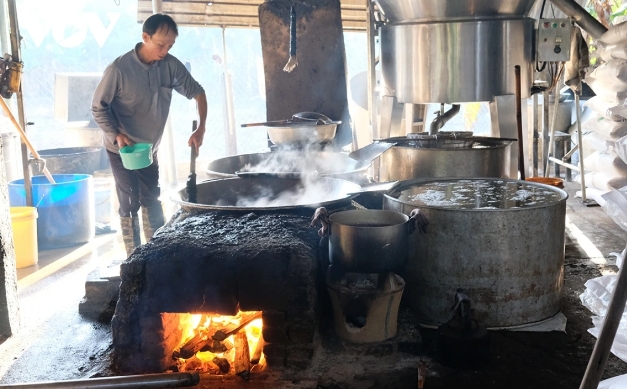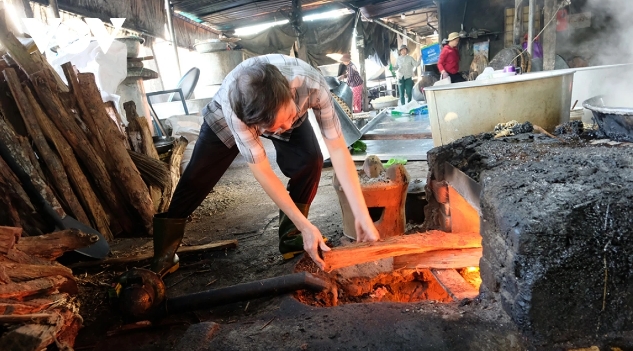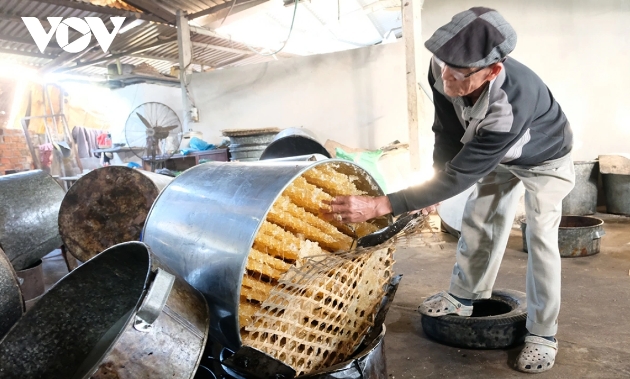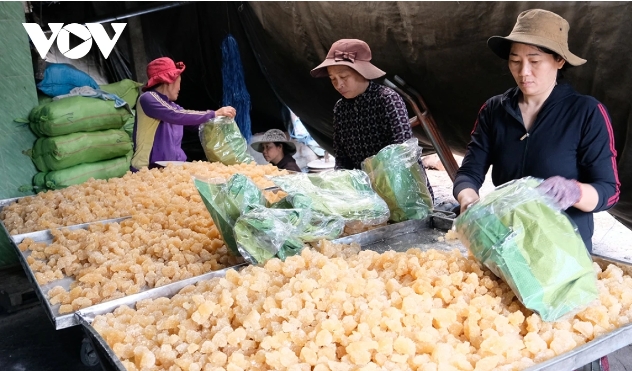Rock sugar village in central Vietnam bustling in buildup to Tet
VOV.VN - In the days leading up to the Lunar New Year 2025 (Tet), the sugar production facilities in Nghia Dong commune, Quang Ngai province, are busy from early morning until late at night producing batches of sugar to meet customer demand.

Recent days has seen the atmosphere intensify at the Bang Lam sugar processing facility. Dong Van Chinh, 71, works in Village 2 of Nghia Dong commune from early morning to late at night as the boiling sugar cauldrons release a fragrant aroma throughout the village. Chinh revealed that he is the fourth generation in his family to make the rock sugar.
He recalled that there was a time when the alluvial plain along the Tra Khuc River was a large sugarcane granary. During the harvest season, buffaloes in the village had to pull sugarcane presses, and the whole village would light fires to cook the sugar syrup.
Back then, there was no white granulated sugar, and rock candy was made from sugar syrup. Today, there is no longer sugar syrup, so the locals use granulated sugar. The sugar is cooked entirely by hand. The yellow and white colors of the rock candy are not from artificial colouring but from the raw materials of yellow and white granulated sugar, with no bleaching process involved.

In the past, Chinh’s facility could produce more than a tonne of rock candy per day, but now it only produces about half that amount.
Chinh still maintains a workforce of 7, with each worker earning between 200,000-300,000 VND per day.
According to the local man, the process of producing rock sugar is the most complicated compared to the making of other specialties in the province.
As usual, local people mix three portions of sugar with two portions of water before then boiling the mixture in a huge aluminum cauldron. Then, they put chicken’s eggs into the pan to purify the mixture before peanut oil is poured into the cauldron to calm the boiling liquid. The next step is to pour the sugar on a big cloth to filter the remaining impurities and again heat the liquid before leaving it in a big jar from seven days to nine days as the final process of making rock sugar.
“From 150 kg of factory sugar, we get about 105 kg of rock candy, and the rest is molasses waste,” shared Chinh

Meanwhile, the Dung Van Sugar Processing Facility, run by Tran Thi My Dung, 67, in Nghia Dung commune, has two cooking stoves, employing a total of 12 workers. Dung has been involved in making rock candy for over 22 years. Every day, her facility produces nearly a tonne of rock candy for the market.
In her opinions, the most important step is to monitor the sugar’s readiness. Once it’s done, it’s poured into containers that already have threads inside. After 7 or 9 days, the sugar will crystallize, then the molasses is separated from the pure rock sugar, which is then dried, packed, and sold to traders.
“In general, rock candy is very popular now. In the past, people used a lot of monosodium glutamate, but now they reduce it and use rock candy. We cook white sugar to make white rock candy, and yellow sugar to make yellow rock candy. It's all done very cleanly and carefully. We must use eggs and lime to form the crystals,” said Dung.

Nghia Dung commune has nearly 10 traditional rock candy and rock sugar processing facilities. Among these, the products of two facilities have been recognized with 3-star OCOP certification.
In 2022, the Intellectual Property Office under the Ministry of Science and Technology granted a trademark registration certificate for Nghia Dung rock candy to the local Farmers’ Association. The local authorities are guiding the facilities in completing procedures to list their products on e-commerce platforms to promote the Quang Ngai rock candy brand to consumers.



